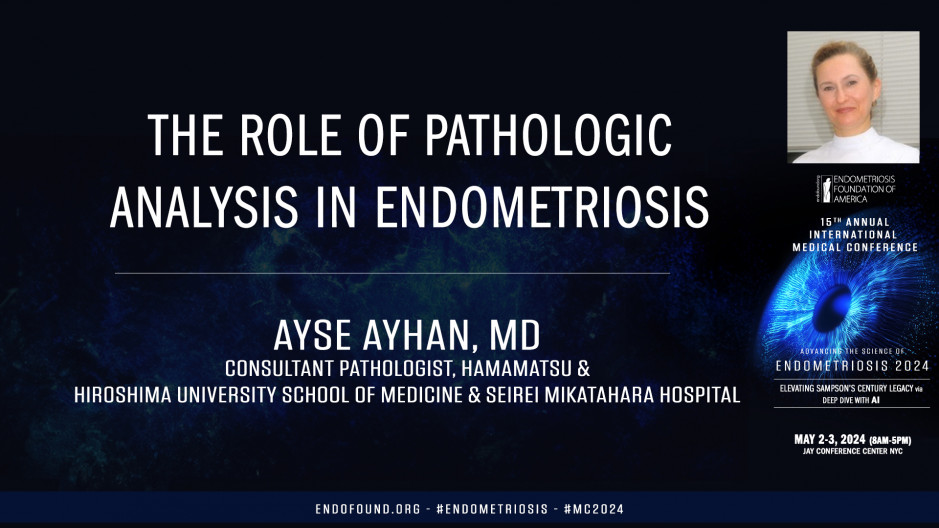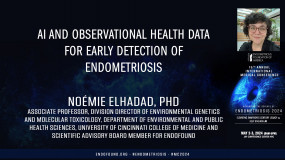International Medical Conference
Endometriosis 2024:
Elevating Sampson’s Century Legacy via
Deep Dive with AI
For the benefit of Endometriosis Foundation of America (EndoFound)
May 2-3, 2024 - JAY CENTER (Paris Room) - NYC
Good afternoon. I want to express my gratitude to Dr. Kin, Dr. Martin, and all the organizers of the conference for letting me share my experience and opinions. I also would like to thank you for your attendance. I am sorry for the attendees who think that I'm here again, pathology again, but I was asked to talk about the importance and the role of the pathology in endometriosis. What is pathology? Pathology is the basic element for information, communication and documentation in medical science, and currently is the only scientific source for proof verification. So-called evidence in terms of tissue DI or discipline also is strongly related to critical watching and observation ed by analysis and synthesis. It is not solely a microscope or microscopic diagnosis, but it is a science using a variety of techniques. Starting from micro anatomy includes physiology, physiopathology, and extends to microscope along with molecular techniques to diagnose and clarify the etiology and the pathogenesis of disease.
The pathologist should know normal biology, anatomy, physiologies, and so-called or all normal and altered states to use in differential diagnosis. Can we differentiate a tissue whether this is endometrium or endometriosis? What do you think for following picture? Is this endometrial or endometriosis? I want to inform beforehand that we may not tell properly if we do not know the location of sample. However, when we respect the anatomy, we see that this is utopic endometrium from its normal site, from the inner lining of the osirus of an hysterectomy sample. Again, the question is whether we can differentiate endometrium or endometriosis. What do you think this is? When we respect an anatomy, we see that this is an aosis, although this sample is again from the uterus. It is not from the inner lining, but it's small deep in material called adenomyosis. How about this one? Can you tell whether this is endometrial or endometriosis? Let us see. Based on the anatomical location, we diagnose it as endometriosis because this is from the ary of the patient. How about this picture? Is it endometrial endometriosis based on anatomical location? We can diagnose this as endometriosis because this is deep. It is from the deep in the colon wall of this particular patient, although the morphology is totally similar to death of endometrium, I'll not ask the question again. I'm sure you're speculating. This is an appendectomy sample from dr. Do kin's files with its widespread endometrioid fo.
How about this rather a few of tissue? Is it endometriosis? No, it is utopic endometrial from A DNC material, so it makes sure that it is not the amount of sample, it is the anatomical location, but gives us clue about the correct diagnosis. Furthermore, atopic endometrium is so heterogeneous that pathologists should consider not only the anatomical details, but also all the physiological and physi pathological alterations for the diagnosis. It is the responsibility of the pathologist to appreciate, recognize and consider anomic and the anomic details for appropriate diagnostic and research purposes. Please notice the slide number for what I will show you next. I put the bottom part of each slide with its number to assure you that all these pictures are from the same sample and even from the same endometrium, from the same patient. Of course, we should then start to think about whether this heterogeneity is the background pathology of the patient or it is just the heterogeneity of the organ itself.
It is so heterogeneous, but heterogeneity within the same sample, maybe also across patients with different menstrual timing with different symptoms, but please make sure all lesions are just simply benign here. So this is heterogeneity across patients and periods. So endometriosis is morphological, heterogeneous and dynamic, which is partly because of the heterogeneity of endometrial itself. Understanding endometrial physiology underpins menstrual health and related diseases. So a pathologist needs to know all the physiological and related physi pathological conditions, which includes the knowledge of immunology, contribution of hormones, hormone receptors, residualization, inflammation, inflammatory cells, cytokines, and their effect on histology and morphology. GY obstetricians know well that a pathologist can diagnose and differentiate dating not only in menstrual OIDs or earlier late proliferative phase, but specifically the pathologist is able to provide plus minus one day daily endometrial dating, especially in secretary phase of the cycle. This is based on epithelial and stromal alterations, inflammatory cells, the locations, vascularization, stromal vessels, alterations, and all the pathological lesions including ovulatory dysfunction, polyps, exogenous or endogeneous hormone effects, coop, neuropathies, and other causes of abnormal bleeding.
The heterogeneity of endometriosis is both spot on, automatical and temporal. We normally embed the tissue in parum block before cutting by microtone into five micron thickness. Putting on a glass slide glands may be embedded deep in stroma in three dimensionally, so that necessitates evaluation of tissue because you don't see, you may not see any gland at the cut level from the top of the block. After many levels we can find after many step sections or sometimes we cut until the block is exhausted or all the tissue runs out or tissue comes to an end to find a diagnostic element.
So these step serial sections necessitating to cut entire tissue goes back to hut to 1957. So this is the spa heterogeneity of endometriosis. Also, the heterogeneity and the dynamism is anatomical. The best example for anatomical heterogeneity may be endometrioma. For example, disappearance of endometriosis is from diaphragm, but this appear is from ovary. Usually endometriosis in ovaries are prone to cyst formation. Perhaps the tissue allows cystic dilatation or it is perhaps the blood often of functional endometriosis that accumulate in gland lumina to cause cystic morphology and chocolate appearance. So ovarian endometriosis is almost always cystic, which also allows the diagnostic in this particular location. This auto heterogeneity is also temporal.
Many studies examined whether lesions are progressive. This must be a very early peritoneal endometriosis, hard to see to a neck eye, but later on it may be more visible by altered colors or altered tissue morphology, and later on when it goes deep into tissues, all the vascularization color changes, tissue texture alters. So these are expected to be progressive disease, although we don't know well the appropriate timing that affecting lesions. When we talk about temporal heterogeneity, of course some part overlap with clinical appearance. So many clinicians try to find out similarity between laparoscopic appearance of the lesions and the positive histology along with hormone usage, for example, and some researchers suggest that they may have different rates of positive pathology based on lesion appearance. Also, they suggest that hormone use specifically influence lesion appearance at the time of surgery with clear lesions more prevalent. Also, it is generally told that the lesion appearance alters based on the duration of the lesion, based on the depth of penetration, localization of the sample and menstrual cycle phase, at least apart from endogeneous or exogenous hormone effect on morphology of an endometrioid technicians. We have many unknowns because of the lack of standard design protocols and diagnostic criteria. In surgical and pathological practice, call it endometriosis when we see glands and stroma along with macrophages, at least two of them including an endometrioma, but we don't need whether we have to see glands to call it endometriosis. Why stroma or stroma? Endometriosis is not enough to call it endometriosis. We almost always see inflammatory cells. How should be the proportion?
How specific is CD 10 to call it endometrial? Should we constantly used immunostain, should be used other immuno stains other than CD 10, like pox eight or IFIT M1. Furthermore, we don't know whether pathologists should examine and report estrogen and receptors. Should the pathologist report the presence of the ization? Should we use surgeon specific surgeon required reports or should we use and uniform reporting format for endometriosis? This is especially for explanation of CD 10. These are peritoneal clusters without any gland, which is confirmed by CD 10. Stromal endometriosis. We know that stromal endometriosis is associated with bonafide endometriosis In many cases here these are glands. Within is then a cellular tissue in ovary. Some may think that this is an ome trauma. Others may suggest that this is ovarian trauma. So to clarify, this is we perform CD 10 to verify that it is endometriosis and these are not residual cystic basis, but these are endometriosis glands. However, not old endometriosis lesion lesion and not all trauma is positive for CD 10. Here, this is an endometriosis. Some cells are more positive than others and some are totally negative, so we don't know the reason of this yet.
STR alone occurs only in five to 6% of operated cases according to DR. Do in the data. S STR could find stromal endometriosis in 5% of cases alone and based on mark luggage, 140 cases published in Journal of Clinical Pathology in 2009, the stromal endometriosis percentage alone was 6%. Another antibody similar to CD 10 is called interferon inducible. Transmembrane protein I-F-I-T-M bond is a novel antibody and suggested to be a sensitive marker. It is advisable to diagnose endometrioid stromal cells in extra genital locations. However, this is not uniformly used and sometimes less strong, sometimes stronger. Compared to CD 10 itself. We continue to use CD 10, which is nci. It's an endo peptidase and the enzyme a member of the method of protease family, but CD 10 also demonstrates stem cells. CD 10 is the precursor of lymphoid cells, and it is also called common acute lymphoblastic leukemia marker special for CDT positive macrophages.
It is not specific for endometriosis at all, but it strongly stains endometrial trauma in inflammatory cells and their contribution to disease is expected because inflammation is an indigenous component of atopic endometrial. However, the relational endometriosis with autoimmunity, the regulatory cells and their alterations, T-cell subset imbalance, macrophages, natural killer cells and their epi or autoimmune properties along with progesterone resistance and hormonal media is not clarified yet. In the case of any diagnostic or prognostic help, pathologists should report, however, currently this is not far from research and not conclusive. Similarly, thus fibrosis occur as a postoperative reaction. What is the definition of fibrosis? Is it just fibroblast? Do we need myofibroblast? Do we need the presence of collagen? Which type of collagen?
How often do we see without endometrial or glandular stromal elements? Is it reactive? Is it an immune property? Is it chicken or egg? Is it a secondary reaction? Is it a wound healing? We don't know very well yet, although there are many papers concerning natural killer cells, inflammation and macrophages and fibrosis. As a consequence, there are many problems. Many caveats occur in endometriosis reporting, including the endometriosis incidents. As far as we need, the pathological confirmation of the disease operated patients or ablation operations would never be included in endometriosis incidents data. Furthermore, association with other such as large myomas or presence of cancers, the report may not include and the endometriosis incidents would be underestimated. This may be also due to sampling errors due to lack of clinician awareness or pathologist preference and unintentional surgical material because clinician was not noticing this lesion. Furthermore, quite commonly distinct locations such as uter cervix, fallopian tube endometriosis are often missed and it is suggest some people say that ovary is the most common, but apparently peritoneal endometriosis is the most common, so incidences and ratio alters based on pathological confirmation of disease. Here you can see an association with many omas, although the patient has widespread peritoneal endometriosis, it may be missed due to the pathologist unintentional mist. We do not know whether pathologists should make a special effort, should be map to terrorists like I do here and submit all the material to clarify and map even when clinician doesn't think about endometriosis.
When I did in this particular patient, I could find so many endometriosis and other myosis foci specifically in peritoneum and in uterine cervix along with the deep and surface of the tissue. So if we look for it, watch for it, the detection rate increases, but this necessary specific efforts and should we do it or not? We do not know. I of course, detection rate increases if we specifically apply particular techniques to learn the disease. We also do not know whether we should apply this, but it apparently increases the detection rate and helps lesion mapping. This is a technique which Japanese pathologists use for early cancers to ping and then map all the lesion for diagnostics. This was applied for some peritoneal endometriosis patients by DR stage skin and detected lots of peritoneal endometriosis.
Another technique well known for many of you is aqua blue contrast technique, thinking that what is invisible to humanize doesn't mean it is non-existence. Kin's aqua blue technique for endometriosis surgery is important for better histopathological detection of non pigmented lesions, which are invisible to human eye after excision and ing. Better histopathologic detection of these lesions including peritoneal stromal endometriosis, bothe was possible. This technique significantly better, detects the peritoneal or curl lesions along with fibrotic and inflammatory foy compared to conventional laparoscopy even by the same surgeon, namely Dr. Sachan. Furthermore, it is clear that it is helpful for the patient because the recurrent operation rate in this group of patients operated with and without ALU technique low recurrence by Kaplan Meier analysis. Of course, this was possible by tonical landmarks of pelvis and appropriate localization of the lesion that improves the results when we analyze our data. Finally, I hopefully think that pathology should lead to terminology classification and staging of endometriosis.
We have problems in nomenclature due to variable terminology and staging, although we try to use the same terminology. We still have trouble in understanding clearly the individual usage including peritoneal endometriosis, its temporal sequence and the staging including, for example, the presence of endometrioma is always make the disease deep or not, or does diaphragmatic angle also mean for a second? These are all mistakenly using terminology. Pathology based constant and uniform nomenclature should be a must. Of course, a gold standard reproducible, well organized, pathology based classification and staging system is necessary for successful treatment. We should obey terminology. We should know that we stage the patient. We do not stage the lesions. Lesions may be early or late in a certain stage, we should not know that not every lesion from a certain stage of patient is expected to be the same, so all classification should specify distribution Extension intensity should be helpful for determination of prognosis and management guidance and should enable discussions about treatment and prognosis between collaborating providers, also between providers and patients. Furthermore, should be convenient. Pathology and pathologist should be a must for this disease and we should know that the scientists and clinician without pathologists are blind. Pathologists without scientists and clinicians are deaf and blind. Research without pathologists may lead mute efforts. Thank you very much for your attention.










